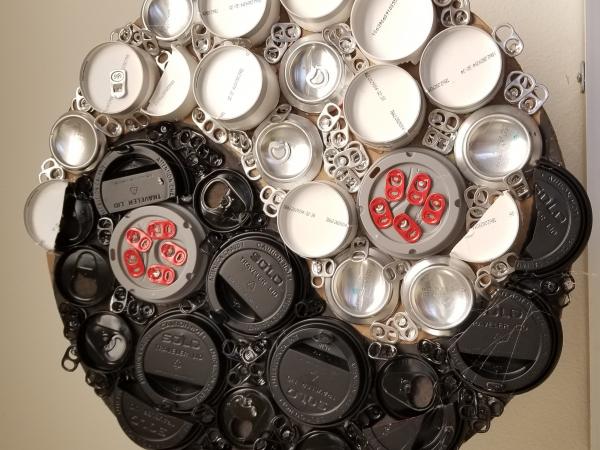Educator Resources
Environmental Found Object Sculpture

Students explore environmental science concepts through their exploration of the local environment.
Students will use found objects that are often discarded and repurpose them to create a found object sculpture. Key concepts surrounding this project are single-use and disposable items and their impact on the environment, recycling and repurposing. Students are asked to sculpt a form that communicates a message about the environment.
Objectives:
- Students will learn about sculpture, found object sculpture and assemblage as art forms
- Students will design a composition that communicates a message about the environment
- Students will choose the found objects, form and color scheme of their sculptural piece in an effort to help communicate their desired message
- Students will construct a found object sculpture that communicates a message about the environment
- Students will write a two-to-three sentence statement about their piece, the objects used and the message they are communicating
Basic Outline of the Lesson:
- Using the slideshow, introduce the Project and show examples of sculpture, found object sculpture and assemblage. Discuss the differences & similarities
- Students begin brainstorming/sketching ideas
- Students collect found objects (during class and outside of class)
- Students begin sculpting
- Students continue sculpting
- Students complete sculptures, title their work and write an artist statement
- Students display their sculptures, artist statement, give feedback and discuss
Art Supplies:
- found objects
- adhesive
- wire and/or string
- spray paint
- backer or base support board as needed
Other Resources:
- Slideshow to introduce project, related artwork and concepts
- Found objects (students find in and out of class, teacher provides some as well)
Technology:
Access to computer for viewing the PowerPoint slideshow.
Idaho State Learning Standards:
Arts and Humanities: Anchor Standard 1: Generate and conceptualize artistic ideas and work.
- VA:Cr1.1.la: Use multiple approaches to begin creative endeavors
- VA:Cr1.2.la: Shape an artistic investigation of an aspect of present-day life using a contemporary practice of art or design
Arts and Humanities: Anchor Standard 2: Organize and develop artistic ideas and work.
- VA:Cr2.1.lla: Through experimentation, practice, and persistence, demonstrate acquisition of skills and knowledge in a chosen art form
- VA:Cr2.3.llla: Demonstrate in works of art or design how visual and material culture defines, shapes, enhances, inhibits, and/or empowers people's lives
ESS3.C: Human Impact on Earth Systems:
- Though the magnitudes of human impacts are greater than they have ever been, so too are human abilities to model, predict, and manage current and future impacts. (ESS3-HS-5)
Academic Language:
- Subject area language: human impact, environment, pollution, waste, ecosystem
- Art language: found object, sculpture, assemblage, disparate, form, color scheme
Student Use of Vocabulary:
Students will use the words when creating their sculptures, when writing about their work in their artist statement, and when discussing their projects.
Student Grouping:
Students will work independently.
Day 1 — Introduction
Introduce the project through the slide show
- Discuss sculpture, found object sculpture and assemblage and show artist work
o Ask what similarities and differences they see in each art form - Discuss strategies for brainstorming and planning design. Students should write down and/or sketch out at least 3 different ideas—discuss the importance of this step in success of final design
o What message do you want to communicate?
o What kinds of found objects can you use? - If time allows, students and teachers go for a walking field trip to begin collect objects
o Remind students to find objects on their own time at home or when out and about
Day 2 — Planning and Artmaking
- Students bring in any found objects they have collected and continue sketching their plan and brainstorming their message
- Students begin sculpting their found object assemblage sculptures
Day 3 — Artmaking
- Students continue sculpting. This is the last day of sculpting
- If students finish early, they title their work and begin writing their artist statement
Day 4 — Presentations
- Students will finalize artist statement paragraph
- Students will display their artwork and artist statement and participate in a gallery walk where they will observe each other’s works and give feedback to at least two of their peer’s work. Class discusses what they observed in their peer’s work.
- Sculpture — what it is and visual examples/art
- Found object — what it is and visual examples/art
o (Art 21 — Mark Dion short video) - Assemblage — what it is and visual examples/art
o (Bristol Whale video)
o (One Plastic Beach video)
o Compare/contrast the three approaches to art making - Education and Art Goals
- Project details and plan
- Brainstorming/Planning — idea/message, color scheme, form
- Artist statement question prompts to help students write their own artist statement
- Resources
• What is your piece called?
• What message did you intend to communicate through this project?
• How did you assemble your sculpture?
• How do the found objects you incorporated help communicate your message?
• What form did you choose to sculpt and why? (How does it help communicate your message?)
0 comments
Leave a Comment